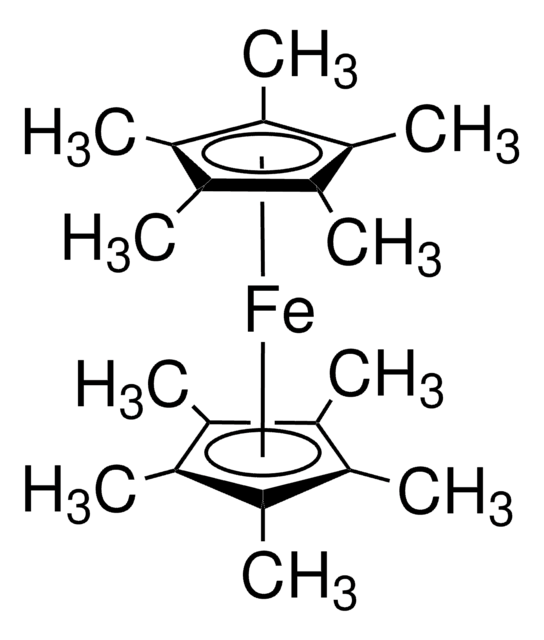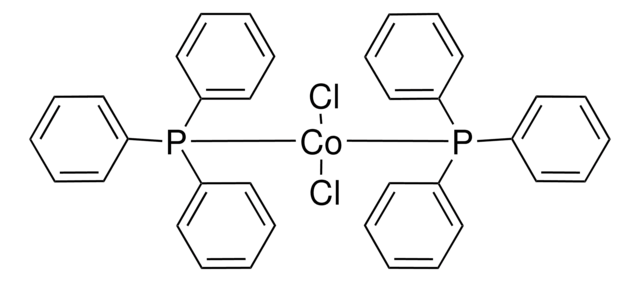401781
Bis(pentamethylcyclopentadienyl)cobalt(II)
Synonym(s):
CoCp*2, Decamethylcobaltocene
Sign Into View Organizational & Contract Pricing
All Photos(2)
About This Item
Empirical Formula (Hill Notation):
C20H30Co
CAS Number:
Molecular Weight:
329.39
MDL number:
UNSPSC Code:
12352103
PubChem Substance ID:
NACRES:
NA.23
Recommended Products
form
solid
reaction suitability
core: cobalt
mp
>210 °C (lit.)
storage temp.
2-8°C
SMILES string
[Co].C[C]1[C](C)[C](C)[C](C)[C]1C.C[C]2[C](C)[C](C)[C](C)[C]2C
InChI
1S/2C10H15.Co/c2*1-6-7(2)9(4)10(5)8(6)3;/h2*1-5H3;
InChI key
XDHJNPINFJSJJB-UHFFFAOYSA-N
Related Categories
General description
Bis(pentamethylcyclopentadienyl)cobalt(II) is a powerful electron donor that is widely used as a dopant to prepare molecular semiconductors due to its low solid-state ionization energy (3.3 eV). The dopant improves charge injection and transport in electronic devices.
Application
Bis(pentamethylcyclopentadienyl)cobalt(II) can be used as:
- An n-type dopant to fabricate organic electronic materials such as copper phthalocyanine thin films.
- A reducing agent to synthesize high-quality reduced graphene oxide thin films at room temperature.
- A metal organic precursor for plasma-enhanced atomic layer deposition of cobalt.
Storage Class Code
11 - Combustible Solids
WGK
WGK 3
Flash Point(F)
Not applicable
Flash Point(C)
Not applicable
Personal Protective Equipment
dust mask type N95 (US), Eyeshields, Gloves
Certificates of Analysis (COA)
Search for Certificates of Analysis (COA) by entering the products Lot/Batch Number. Lot and Batch Numbers can be found on a product’s label following the words ‘Lot’ or ‘Batch’.
Already Own This Product?
Find documentation for the products that you have recently purchased in the Document Library.
Customers Also Viewed
Plasma-enhanced atomic layer deposition of Co using Co(MeCp)2 precursor
Jusang Park, et al.
Journal of Energy Chemistry, 22, 403-407 (2013)
Decamethylcobaltocene as an efficient n-dopant in organic electronic materials and devices
Calvin K. Chan, et al.
Organic Electronics, 9, 575-581 (2008)
Reduction of Graphene Oxide Thin Films by Cobaltocene and Decamethylcobaltocene
Molly M. MacInnes, et al.
ACS Applied Materials & Interfaces, 10, 2004-2015 (2018)
Carolyn N Valdez et al.
Journal of the American Chemical Society, 140(28), 8924-8933 (2018-06-20)
The effects of a variety of monatomic cations (H+, Li+, Na+, K+, Mg2+, and Ca2+) and larger cations (decamethylcobaltocenium and tetrabutylammonium) on the reduction of colloidal ZnO nanocrystals (NCs) are described. Suspensions of "TOPO"-capped ZnO NCs in toluene/THF were treated
Our team of scientists has experience in all areas of research including Life Science, Material Science, Chemical Synthesis, Chromatography, Analytical and many others.
Contact Technical Service











